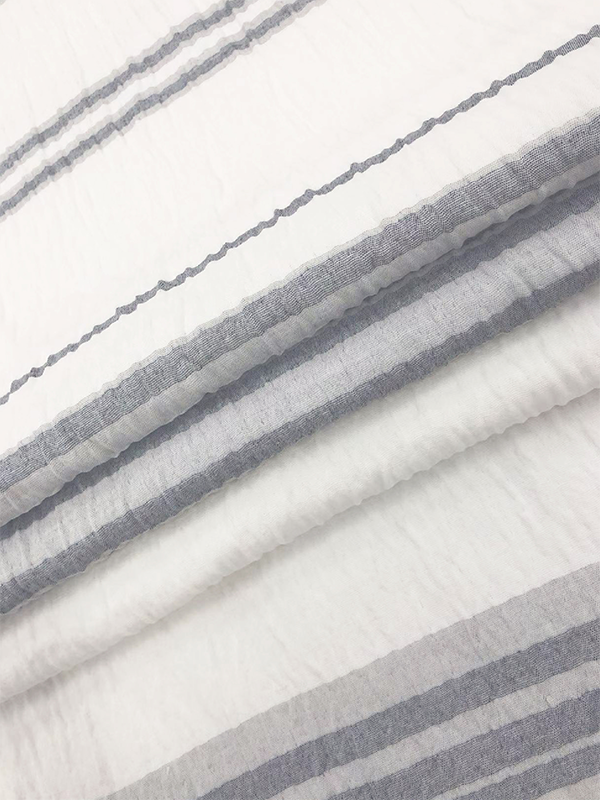Curtain fabric plays a vital role in home décor, offering both practical benefits and aesthetic appeal. As an essential component of window treatments, the fabric you choose for your curtains can dramatically impact the ambiance, privacy, and functionality of a room. Curtain fabrics come in a wide variety of materials, styles, and patterns, each designed to meet different needs—from light filtering and insulation to enhancing the look of your space.
One of the main characteristics of curtain fabric is the vast array of materials available, catering to various design preferences and functional needs. Common materials used for curtains include:
Known for its lightweight and breathable nature, cotton curtain fabric is ideal for spaces where you want light filtering and airflow while still maintaining some privacy.
Polyester is a durable and easy-to-maintain fabric, resistant to shrinking, wrinkling, and fading. It’s a popular choice for busy households or commercial spaces.
Linen curtain fabric offers a sophisticated, natural texture and is highly breathable. Although linen wrinkles easily, its casual elegance makes it a favorite for more relaxed, natural styles.

Velvet is a luxurious, heavyweight fabric that offers excellent light blocking and insulation. Its rich texture makes it perfect for more formal or dramatic settings.
Silk curtain fabric adds a touch of luxury to any room with its glossy sheen. However, silk is more delicate and requires careful maintenance, often used in high-end or decorative spaces.
The type of fabric you choose can impact not only the look but also the function of your curtains, making it essential to select the right material based on the specific needs of the room.
Curtain fabric serves an important functional role by helping control the amount of light that enters a room. Different types of fabric offer varying degrees of light filtration:
Light, translucent fabrics like voile or chiffon allow natural light to enter the room while providing minimal privacy. These are perfect for living rooms, dining rooms, or spaces where you want to enjoy natural sunlight while still maintaining some level of privacy.
Mid-weight fabrics like cotton and linen provide more privacy while still letting in some light, making them ideal for bedrooms or offices where a balance of natural light and privacy is desired.
Thick, heavyweight fabrics like velvet or specially designed blackout curtains block almost all light, offering maximum privacy and darkness. These are commonly used in bedrooms, media rooms, or any area where light control is critical.
The light control properties of curtain fabric make it a valuable addition to rooms where you want to manage natural light for comfort, relaxation, or productivity.
Curtain fabric can also contribute to the insulation and energy efficiency of a room. Heavier fabrics like velvet, wool, or polyester blends help trap heat in the room during colder months and block external heat during the summer. This thermal insulation helps maintain a comfortable indoor temperature, reducing the need for excessive heating or cooling and saving on energy costs.
In addition, some curtain fabrics come with thermal or insulated linings that enhance their energy efficiency even further. These lined curtains are especially useful in spaces with large windows or where temperature regulation is a concern, such as living rooms, bedrooms, or offices.
In addition to light control and insulation, certain curtain fabrics offer sound-absorbing properties. Heavier fabrics like velvet, suede, or thick polyester help reduce noise pollution by absorbing sound waves, making them an excellent choice for urban environments or rooms near busy streets. These sound-dampening curtains create a quieter, more peaceful atmosphere, particularly in bedrooms, home theaters, or study areas.
Curtain fabric is a key element in interior design, contributing significantly to the overall style and ambiance of a room. From minimalist, contemporary designs to more ornate, traditional styles, there is a curtain fabric to suit every décor theme.
Curtain fabrics come in a wide variety of patterns, including florals, geometric designs, stripes, and abstract motifs, as well as solid colors that can complement or contrast with the room’s color scheme.
The texture of the fabric also adds a tactile dimension to the room. Smooth fabrics like silk and satin give a sleek, modern feel, while textured fabrics like linen or velvet offer a more rustic or luxurious touch.
The way curtain fabric hangs or drapes is another important design consideration. Some fabrics, like silk or velvet, drape elegantly and provide a formal, dramatic look, while lighter fabrics like cotton or polyester give a more casual, relaxed appearance.
By carefully selecting the design, texture, and drape of your curtain fabric, you can enhance the overall look and feel of any space, making the curtains not only functional but also a stylish focal point.
Curtain fabrics are available in varying degrees of durability, with some materials better suited for high-traffic areas or long-term use. Polyester and blends of synthetic fibers are highly durable, resistant to fading, shrinking, and wrinkles, making them easy to care for and long-lasting.
Natural fibers like cotton and linen may require more care, as they can shrink or wrinkle easily, but they offer a soft, breathable quality that some homeowners prefer. It’s important to consider the cleaning and maintenance requirements of your curtain fabric to ensure its longevity.
For instance, some fabrics are machine washable, while others, like silk or velvet, may require professional cleaning. Selecting a fabric that aligns with your lifestyle and maintenance preferences will ensure your curtains remain beautiful and functional over time.

 English
English 中文简体
中文简体 Español
Español عربى
عربى












